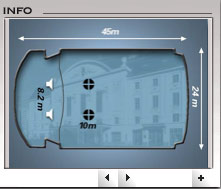

Orchestral Stage Positioning Using Altiverb 6
December 2003 Audio Ease went to several rooms to make samples using a larger than usual set of source positions. The goal was to find out what exactly the influence of stage position is on the impulse response, so an algorithm could be derived that allows the source sound to be moved around on the stage of any hall or room available in Altiverb. The following is a demo using Altiverb 6's resulting 'stage positions' feature for a specific case: Creation of a convincing stereo image of a sampled orchestra on a stage.

First, listen to what the stage position control in Altiverb can do. The three pictures below are interface screen shots of three settings. The mp3 below it is the result of the three settings. Input audio is a stereo mixdown of part of the percussion section of the demo, therefore you see two speakers on the stage.

Maarten's demo
We asked Maarten Spruijt, maker of primary demos for such renowned sample manufacturers as Vienna Symphonic Library, Spectrasonics and ProjectSAM, to compose a short movement for us. As his instrument he chose to use the Vienna Symphony Library of orchestral samples. This is what his dry, un-positioned orchestra sounded like.
After that we asked him to distribute his separate instrument tracks over the stage using Altiverb 6's stage position feature. Each track was to played back from a different position on stage.
Instrument track inserts
First thing to do was insert an Altiverb in each of the 15 instrument tracks. Each Altiverb loaded with the same microphone setup. A setup close to a stage was chosen to achieve a wide stereo image, The Vienna Konzerthaus 10 m omni directional mics:
:
To ease the load on the CPU, the choice was made to not render the full tail in the instrument tracks, just the direct sound and the early refs. (In the master fader, one Altiverb will take take care of the tail.)

Selecting Instrument Positions
Then the Altiverbs were switched to their Stage positions tabs (as shown above in threefold).The previous picture shows that the direct gain control becomes disabled, as the Stage positions control takes over the gain of the direct sound.
Stage positions were selected, by dragging the speaker for mono instrument tracks, or by dragging both speakers for placement of stereo mixdowns of instrument groups. Classic Orchestral Positions were selected, with percussion in the far back of the stage.
Maarten's tracks now sounded like this:
A single master Altiverb for the reverb tail
With all of the instruments placed properly (Maarten's positionings are available in the preset menu under "/Orchestral/Orchestral Positioning track inserts/") a final Altiverb was put in the master channel to take care of the reverb tai, and Mechanics Hall in Worcester MA was selected to provide it. The instrument tracks now provided the direct sound and early refs in the production, so the direct sound of the master Altiverb was set all the way down, as well as some of its early refs.

With the master now only rendering the tail, the mix between the placement and the tail could be made using the wet/dry control of the master Altiverb.
Results
The final result is below. A very convincing orchestral stage, that could not have been achieved using traditional panning.
Alternatively, here's a wetter setup, that makes use of the Amsterdam Concertgebouw for the reverb tail.(Maartens alternatives are available in the preset menu under Orchestral Reverb Tails)
The demos can best be listened to on speakers. You can download the MP3's on this page as 44.1 k 16 bits AIFF files form here.